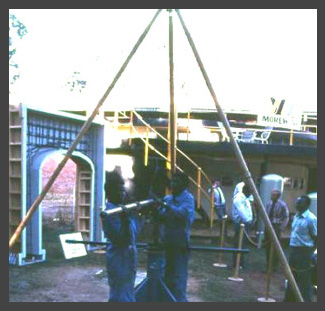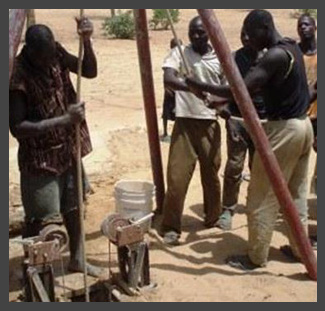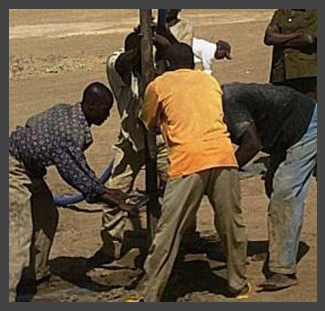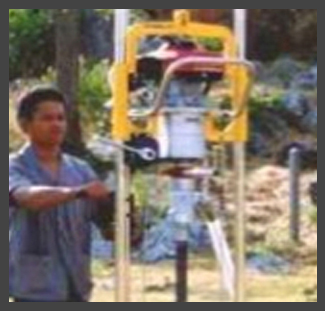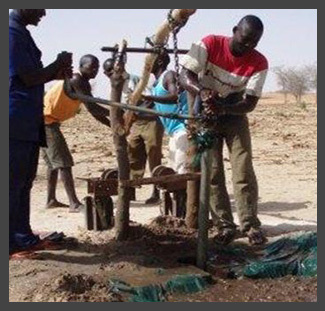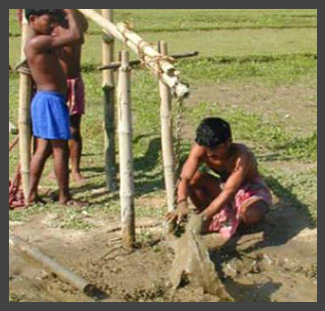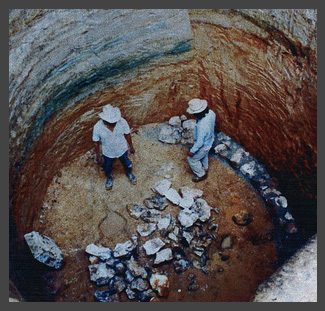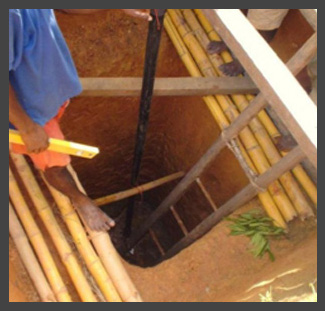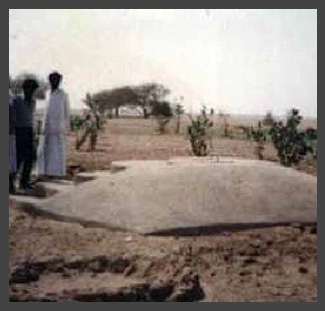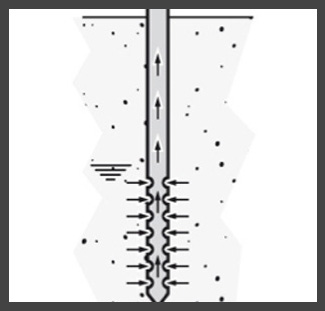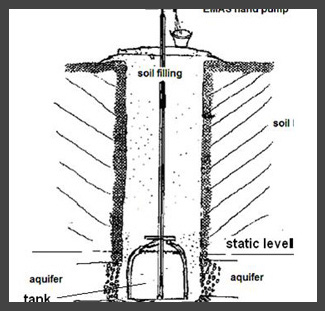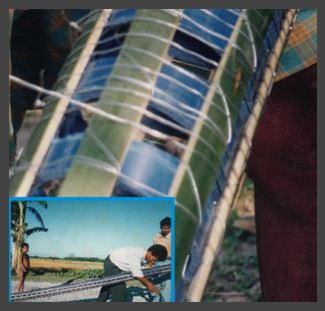Difference between revisions of "钻井或挖掘井"
From Akvopedia
Weichen Chen (talk | contribs) (→Manual drilling comparison of methods) |
(→人工钻井链接) |
||
| (11 intermediate revisions by 2 users not shown) | |||
| Line 1: | Line 1: | ||
| − | {{Language-box|english_link=Drilling or digging |french_link=Forage ou excavation |spanish_link=Coming soon|hindi_link=Coming soon|malayalam_link=Coming soon|tamil_link=Coming soon | korean_link=Coming soon | chinese_link= | + | {{Language-box|english_link=Drilling or digging |french_link=Forage ou excavation |spanish_link=Coming soon|hindi_link=Coming soon|malayalam_link=Coming soon|tamil_link=Coming soon | korean_link=Coming soon | chinese_link=钻井或挖掘井 | indonesian_link=Coming soon | japanese_link=Coming soon}} |
获取地下水资源不是一件轻而易举的事情,本节将讲解许多不同类型的钻井方法(钻井深度及费用各不同)。例如,据说非洲的地下水资源比其他大洲更为丰富。尽管如此,使用机器钻井对于大部分非洲人而言费用太高。与使用机器钻井相比,人工钻浅井(最深35米)的费用降低4到10倍。费用降低后,非营利性组织和政府就能钻取更多的水井,同时村民、农民、学校和小型社区可以在私有企业的援助下自主钻取水井。 | 获取地下水资源不是一件轻而易举的事情,本节将讲解许多不同类型的钻井方法(钻井深度及费用各不同)。例如,据说非洲的地下水资源比其他大洲更为丰富。尽管如此,使用机器钻井对于大部分非洲人而言费用太高。与使用机器钻井相比,人工钻浅井(最深35米)的费用降低4到10倍。费用降低后,非营利性组织和政府就能钻取更多的水井,同时村民、农民、学校和小型社区可以在私有企业的援助下自主钻取水井。 | ||
| Line 12: | Line 12: | ||
|colspan="5" style="background-color:#efefef;"| | |colspan="5" style="background-color:#efefef;"| | ||
|- | |- | ||
| − | |style="background:#efefef;"|[[Image:Auger_drilling.jpg|center|100px|link= | + | |style="background:#efefef;"|[[Image:Auger_drilling.jpg|center|100px|link=手钻-常规]] |
| − | |style="background:#efefef;"|[[Image:Vonder_rig.jpg|center|100px|link= | + | |style="background:#efefef;"|[[Image:Vonder_rig.jpg|center|100px|link=手钻-三脚架钻井机]] |
| − | |style="background:#efefef;"|[[Image:Point_and_well.jpg|center|100px|link= | + | |style="background:#efefef;"|[[Image:Point_and_well.jpg|center|100px|link=手钻-管井]] |
| − | |style="background:#efefef;"|[[Image:Percussion_drilling.jpg|center|100px|link= | + | |style="background:#efefef;"|[[Image:Percussion_drilling.jpg|center|100px|link=冲击钻井]] |
| − | |style="background:#efefef;"|[[Image:Stone_hammer_well drilling.PNG|center|100px|link= | + | |style="background:#efefef;"|[[Image:Stone_hammer_well drilling.PNG|center|100px|link=冲击钻井 — 石锤法]] |
|- | |- | ||
| − | |style="background:#efefef;"|<div class="center" style="width:auto; margin-left:auto; margin-right:auto;">[[ | + | |style="background:#efefef;"|<div class="center" style="width:auto; margin-left:auto; margin-right:auto;">[[手钻-常规 | 手钻–常规]]</div> |
| − | |style="background:#efefef;"|<div class="center" style="width:auto; margin-left:auto; margin-right:auto;">[[ | + | |style="background:#efefef;"|<div class="center" style="width:auto; margin-left:auto; margin-right:auto;">[[手钻-三脚架钻井机 | 手钻- 三脚架钻进机]]</div> |
| − | |style="background:#efefef;"|<div class="center" style="width:auto; margin-left:auto; margin-right:auto;">[[ | + | |style="background:#efefef;"|<div class="center" style="width:auto; margin-left:auto; margin-right:auto;">[[手钻-管井 | 手钻-管井]]</div> |
| − | |style="background:#efefef;"|<div class="center" style="width:auto; margin-left:auto; margin-right:auto;">[[ | + | |style="background:#efefef;"|<div class="center" style="width:auto; margin-left:auto; margin-right:auto;">[[冲击钻井 | 冲击钻井]]</div> |
| − | |style="background:#efefef;"|<div class="center" style="width:auto; margin-left:auto; margin-right:auto;">[[ | + | |style="background:#efefef;"|<div class="center" style="width:auto; margin-left:auto; margin-right:auto;">[[冲击钻井 — 石锤法 | 冲击钻井 — 石锤法]]</div> |
|- | |- | ||
|colspan="5" style="background-color:#efefef;"| | |colspan="5" style="background-color:#efefef;"| | ||
| Line 30: | Line 30: | ||
|colspan="5" style="background-color:#efefef;"| | |colspan="5" style="background-color:#efefef;"| | ||
|- | |- | ||
| − | |style="background:#efefef;"|[[Image:Manually_rotated jetting small.jpg|center|100px|link= | + | |style="background:#efefef;"|[[Image:Manually_rotated jetting small.jpg|center|100px|link=水力喷射 — 综述]] |
|style="background:#efefef;"|[[Image:Emas drilling small.jpg|center|100px|link=Jetting - EMAS method]] | |style="background:#efefef;"|[[Image:Emas drilling small.jpg|center|100px|link=Jetting - EMAS method]] | ||
| − | |style="background:#efefef;"|[[Image:jetting engine small.jpg|center|100px|link= | + | |style="background:#efefef;"|[[Image:jetting engine small.jpg|center|100px|link=喷射-由引擎发动的旋喷]] |
|style="background:#efefef;"|[[Image:Rota_sludge small.jpg|center|100px|link=Sludging - Rota sludge]] | |style="background:#efefef;"|[[Image:Rota_sludge small.jpg|center|100px|link=Sludging - Rota sludge]] | ||
|style="background:#efefef;"|[[Image:Baptist drilling small.jpg|center|100px|link=Sludging - Baptist method]] | |style="background:#efefef;"|[[Image:Baptist drilling small.jpg|center|100px|link=Sludging - Baptist method]] | ||
|- | |- | ||
| − | |style="background:#efefef;"|<div class="center" style="width:auto; margin-left:auto; margin-right:auto;">[[ | + | |style="background:#efefef;"|<div class="center" style="width:auto; margin-left:auto; margin-right:auto;">[[水力喷射 — 综述]]</div> |
|style="background:#efefef;"|<div class="center" style="width:auto; margin-left:auto; margin-right:auto;">[[Jetting - EMAS method|喷射 - EMAS 方法]]</div> | |style="background:#efefef;"|<div class="center" style="width:auto; margin-left:auto; margin-right:auto;">[[Jetting - EMAS method|喷射 - EMAS 方法]]</div> | ||
| − | |style="background:#efefef;"|<div class="center" style="width:auto; margin-left:auto; margin-right:auto;">[[ | + | |style="background:#efefef;"|<div class="center" style="width:auto; margin-left:auto; margin-right:auto;">[[喷射-由引擎发动的旋喷]]</div> |
|style="background:#efefef;"|<div class="center" style="width:auto; margin-left:auto; margin-right:auto;">[[Sludging - Rota sludge|除泥 - Rota除泥]]</div> | |style="background:#efefef;"|<div class="center" style="width:auto; margin-left:auto; margin-right:auto;">[[Sludging - Rota sludge|除泥 - Rota除泥]]</div> | ||
|style="background:#efefef;"|<div class="center" style="width:auto; margin-left:auto; margin-right:auto;">[[Sludging - Baptist method|除泥 - Baptist 方法]]</div> | |style="background:#efefef;"|<div class="center" style="width:auto; margin-left:auto; margin-right:auto;">[[Sludging - Baptist method|除泥 - Baptist 方法]]</div> | ||
| Line 115: | Line 115: | ||
<br> | <br> | ||
| − | === | + | ===人工钻井链接=== |
{|style="font-size: 120%;" cellpadding="5" | {|style="font-size: 120%;" cellpadding="5" | ||
|- | |- | ||
| − | |{{#ev:youtube|_lapu0LB-wM|200|auto|<center> | + | |{{#ev:youtube|_lapu0LB-wM|200|auto|<center>如何在非洲实现专业化的人工钻井 1</center>}} |
| − | |{{#ev:youtube|l-ftnqIpnJU|200|auto|<center> | + | |{{#ev:youtube|l-ftnqIpnJU|200|auto|<center>如何在非洲实现专业化的人工钻井 2</center>}} |
| − | |{{#ev:youtube|3OsMJ3KGzls|200|auto|<center> | + | |{{#ev:youtube|3OsMJ3KGzls|200|auto|<center>实现专业化的人工钻井: 2. 建筑能力(英文)</center>}} |
|- | |- | ||
| − | |{{#ev:youtube|ibyj2BlhENo|200|auto|<center> | + | |{{#ev:youtube|ibyj2BlhENo|200|auto|<center>实现专业化的人工钻井: 4. 定位 (英文)</center>}} |
| − | |{{#ev:youtube|lvfczoIsG4s|200|auto|<center> | + | |{{#ev:youtube|lvfczoIsG4s|200|auto|<center>实现专业化的人工钻井: 2. 钻井技术</center>}} |
|} | |} | ||
| − | * | + | * 视频: [http://www.thewaterchannel.tv/media-gallery/641-manual-drilling-and-pump-installation-madagascar 人工钻井和水泵安装,马达加斯加] by The Water Channel. |
| − | * [http://www.rural-water-supply.net/en/resources/details/402 | + | * [http://www.rural-water-supply.net/en/resources/details/402 人工钻井技术], Richard Carter, Cranfield University, 2005. |
| − | * [http://www.hydrology.nl/images/docs/ihp/nl/cop15/2_Richard_Taylor.pdf | + | * [http://www.hydrology.nl/images/docs/ihp/nl/cop15/2_Richard_Taylor.pdf • 非洲地下水和气候变化:坎帕拉宣言] Richard Taylor, University College London (UK), IAH Commission of Groundwater & Climate Change. |
<br> | <br> | ||
| − | === | + | ===鸣谢=== |
| − | * [http://www.unicef.org/wash/files/04.pdf | + | * [http://www.unicef.org/wash/files/04.pdf 理解人工钻井和地下水]. Unicef.org. |
Latest revision as of 02:24, 18 May 2016
| |
|
|
|
|
|
|
|
|
获取地下水资源不是一件轻而易举的事情,本节将讲解许多不同类型的钻井方法(钻井深度及费用各不同)。例如,据说非洲的地下水资源比其他大洲更为丰富。尽管如此,使用机器钻井对于大部分非洲人而言费用太高。与使用机器钻井相比,人工钻浅井(最深35米)的费用降低4到10倍。费用降低后,非营利性组织和政府就能钻取更多的水井,同时村民、农民、学校和小型社区可以在私有企业的援助下自主钻取水井。
气候变化因素
随着气候变化(如干旱),一些地方的地下水可能会逐渐干涸,因此可能需要钻取更深的水井(费用也会更高)。由于在干旱时含水层的水量变少,就应该避免上层滞水含水层(含水层比水位还高)。滨海含水层可能会遭到咸水的影响,因此一定要检查水质。
Contents
实地经验
这些工程可能会使用人工挖掘或钻井,并且列在了网站Akvo.org的Really Simple Reporting (RSR)|易汇报中。
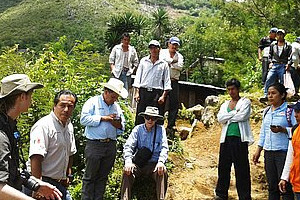 MWA-LAP: 墨西哥 |
 TESO North 学校和社区WASH 工程 |
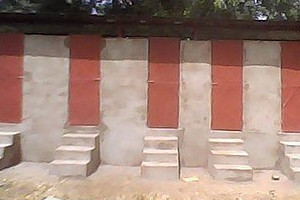 Eau Hygiène et Assainissement(水、卫生与污水排放) |
 Eau, hygiène et assainissement(水、卫生与污水排放) |
 Project Water4Tomorrow(明日之水) | ||
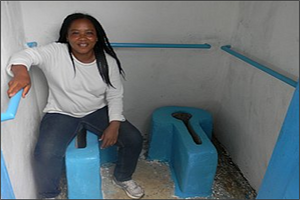 农村水援助 WASH 工程 |
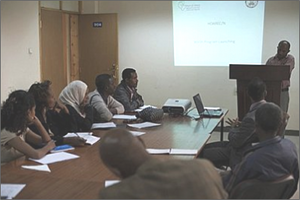 净水工程 |
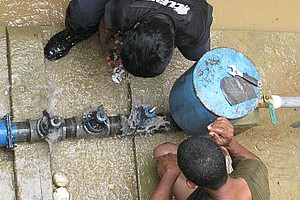 MWA-LAP: 尼加拉瓜 |
 WASH 联盟工程, 埃塞俄比亚的AMREF |
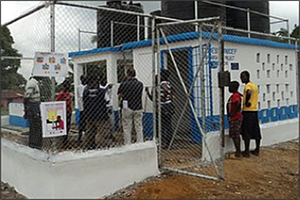 蒙罗维亚城市WASH II | ||
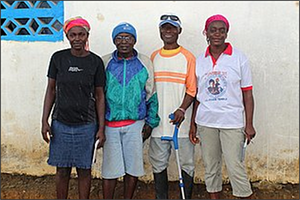 加速净水工程1 |
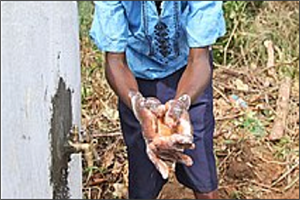 学校儿童 WASH 工程 II |
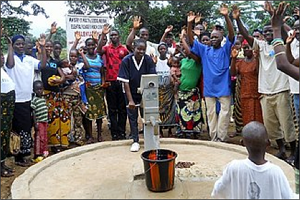 农村钻井和重建1 |
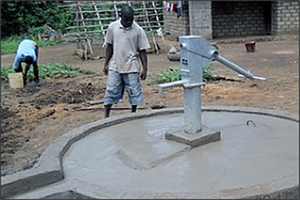 Panta 区农村水工程1 |
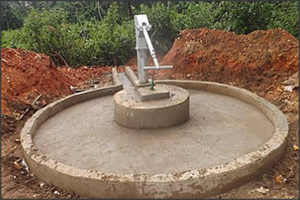 社区水卫生综合工程 | ||
人工钻井方法比较
人工钻井链接
- 视频: 人工钻井和水泵安装,马达加斯加 by The Water Channel.
- 人工钻井技术, Richard Carter, Cranfield University, 2005.
- • 非洲地下水和气候变化:坎帕拉宣言 Richard Taylor, University College London (UK), IAH Commission of Groundwater & Climate Change.
鸣谢
- 理解人工钻井和地下水. Unicef.org.

